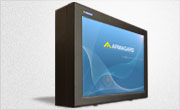Outdoor Digital Signage – Sunlight, Weather, Temperature and Content
Posted by: Richard Williams | Posted on: | 0 Comments
With so many displays now used in indoor environments for digital signage many advertisers and retailers are opting to take their screens outdoors were there is less competition and the audience numbers are greater.But outdoor digital signage is whole new ball game, compared to using indoor screens, with numerous challenges and obstacles that have to be overcome for any outdoor screen to be able to function efficiently without failing.
Sunlight
Often overlooked but one of the most significant challenges for any outdoor digital signage or outside display is the effect of the sun. The sun has several effects on an outdoor display.
Firstly, the brightness of the sun can wash out a display as the LCD (or plasma) backlight has to contend with the brightness; often high brightness displays are used to counteract this problem but they require more energy and generate more heat – which has also to be countered to prevent overheating.
Secondly, direct sunlight can cause sun glare if the sun is directly on the screen. This can be countered with an anti-glare screen although this can reduce the brightness of the display. Another option is to position the screen away from the sun’s rays or even place a canopy or shroud over the display.
And thirdly, direct sunlight can also damage a screen if the sun’s rays are continually bombarding it, hot spots can develop and cause permanent damage to the screen.
Weather and Temperature Protection
Rainfall is perhaps the most common element outdoor digital signage has to cope with but there are other weather systems that need to be countered too: snow, sleet and even airborne dust need to be kept away from the screen but also the varying temperatures that an outdoor display has to work in needs to be factored in.
Commonly, LCD enclosures that house cooling and heating elements are used in outdoor locations as they create the optimum environment for display screens to operate in. Not only are they waterproof and able to keep all the other elements away from the screen but they can keep a constant temperature, even when ambient temperatures plummet below zero or rise to stifling levels. LCD enclosures also provide a steel barrier against vandalism and impacts – also important in outdoor locations.
Content
Another consideration for those thinking of embarking on outdoor digital signage is that the content that works on an indoor display may not necessarily transport to an outdoor location. What may appear fine in an indoor location may appear washed out or confused on an outdoor screen. Colours, fonts and transitions work differently in outdoor locations as they do under false lighting and the screen view time can often be shorter too as people tend to walk about quicker outside so ensuring the important information is always visible is important for any outdoor campaign.
Post shortlink:
Popular Products
LCD Enclosure
Need armor for your LCD/LED screen(s)? Outdoors or inside the versatile LCD enclosure protects against thieves, vandals & the weather. Installation idea: NFL stadiums.
Outdoor Digital Signage
Exclusive 46” outdoor screen protection. Dubbed the ‘Totem’, due to its distinct design, it repels damage threats, but attracts audiences. Installation idea: Drive-thru restaurants.
Portrait Flat Panel Enclosure
Safeguard your eye-level advertising display screen(s), indoors or outdoors. Completely customizable, add exciting features like touch screen technology. Installation idea: Restaurant frontages.
Indoor Digital Signage
Popular purchase for retail outlets! Great for ‘point of sale’ persuasion, boost your brand with static & motion advertising from a single unit! Installation idea: Mall of America.




